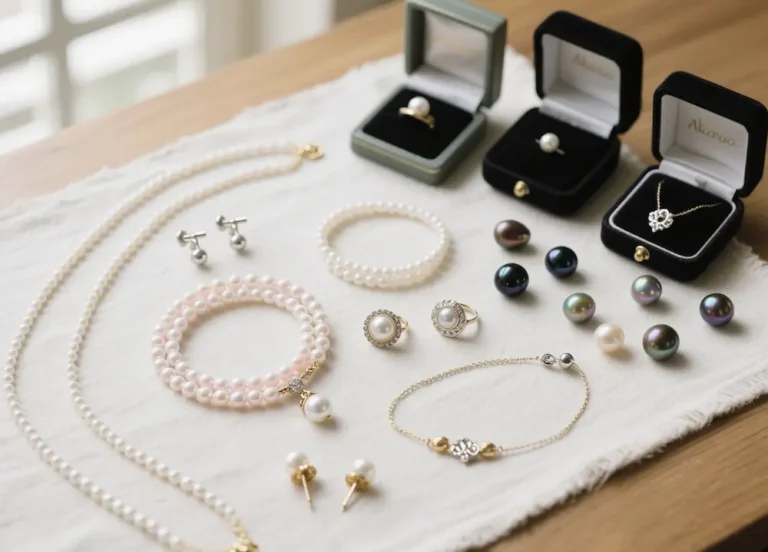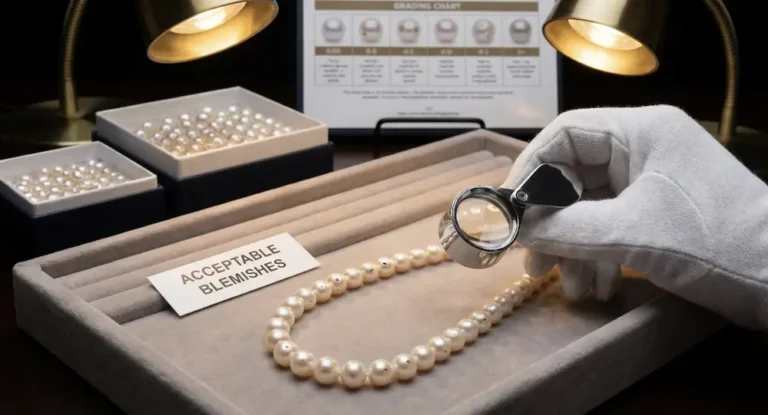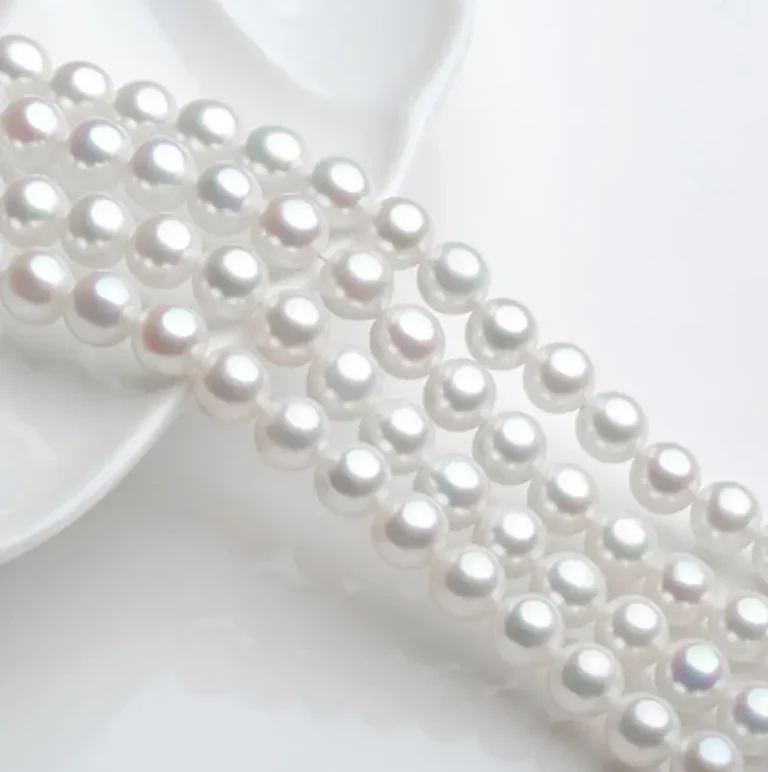Let me settle this right now: Yes, cultured pearls are absolutely real pearls. Period.
I can’t tell you how many times customers have called our operation asking for “real pearls, not those cultured ones.” It drives me crazy, honestly. The confusion is understandable, but as someone who’s spent decades working directly with Pearl Manufacturer operations, I need to set the record straight. What you’re buying at virtually every jewelry store—whether it’s Tiffany’s, your local jeweler, or through wholesale pearls suppliers—are cultured pearls. And they’re just as real as the ones your great-grandmother might have found in an oyster.
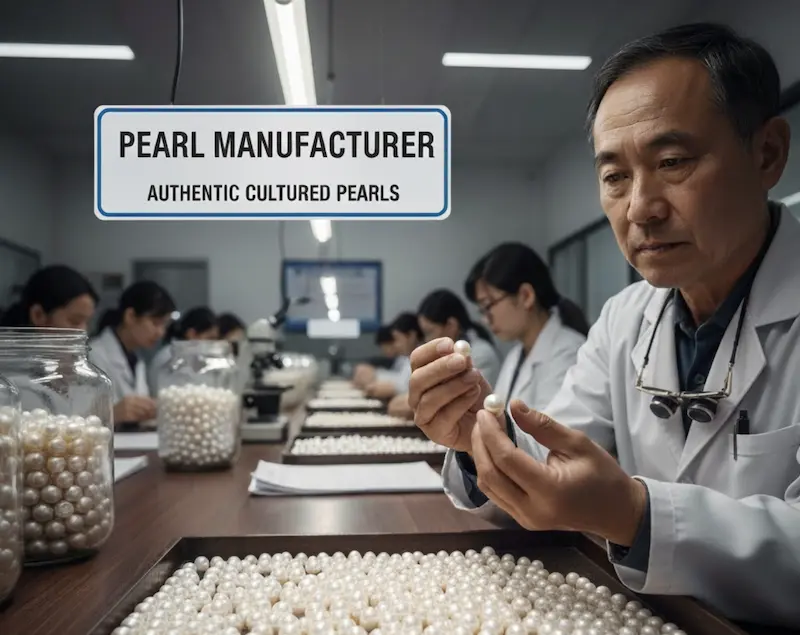
What Exactly Are Cultured Pearls?
This is when things become interesting. Like real pearls, cultured pearls grow inside living mollusks. What makes them different? We give nature a little push.
It’s like gardening for food verses hunting for food. A tomato that comes from a farm is still a real tomato, right? The same idea works here. The biological process that makes pearls has been around for millions of years, and that’s what we use to grow cultured pearls. We just start it on purpose instead of waiting for it to happen by chance.
A competent worker carefully puts a small nucleus, generally a tiny bead fashioned from freshwater mussel shell, and a bit of mantle tissue into a host mollusk. Then the snail does what mollusks do: it starts to make nacre, the gorgeous, shiny substance that gives pearls their unique luster. Over months or years, the nacre builds up surrounding the nucleus in layers. What comes out is a real pearl, made by a living thing as part of its natural protection system.
The Science Behind Pearl Formation
Nacre, which is also known as mother-of-pearl, is what both natural and produced pearls are made of. This is calcium carbonate that has been turned into aragonite crystals and is bound together by a protein called conchiolin. When you look at a pearl using a microscope, whether it’s natural or cultured, you see the same crystal structure.
When something bothers the mollusk, it secretes nacre. A parasite, a piece of shell, or a grain of sand could be that irritant in nature. We purposely add that irritation when we grow cultured pearls. But here’s the most important part: once that nucleus is in place, everything that happens thereafter is completely normal. The oyster doesn’t know or care that a person put it there. It simply reacts in the way that evolution intended.
Understanding Nacre Quality
The thickness and quality of the nacre affect how long a pearl lasts and how beautiful it is. Natural pearls usually have thicker nacre since they have been growing in the wild for a long time, sometimes decades. Depending on the variety, cultured pearls grow over a certain amount of time, usually between 6 months and 7 years.
Don’t let that trick you into thinking that farmed pearls are less valuable. The ways that pearl farmers execute their jobs now have come a long way. High-quality cultivated pearls from well-known Pearl Manufacturer now have nacre thickness that is similar to that of many natural pearls. This makes them last longer and gives them that beautiful shine that everyone wants.
Why Natural Pearls Are Practically Extinct (And Ridiculously Expensive)
Let’s talk about what’s real. It’s really rare to find a natural pearl. To find one good pearl, you’d have to open about 10,000 oysters. Overharvesting for hundreds of years has left most natural pearl beds across the world empty. There aren’t many natural pearls left today. Most of them have already been taken or are kept in museums and private collections.
A strand of natural pearls can easily fetch $1 million or more at auction. Do you remember when Gina Lollobrigida’s pearl and diamond earrings sold for £1.6 million in 2013? Those pearls came from nature. If you’re not a royal or have a jewelry budget of seven figures, you’re looking for cultivated pearls, and that’s a good thing.
The Gemological Institute of America says that more than 95% of the pearls on the market today are cultivated pearls. This isn’t a dirty secret. That’s just how the pearl business works these days.
The Four Main Types of Cultured Pearls
Not all cultured pearls are created equal. Understanding the different types helps you make informed decisions about what you’re buying.
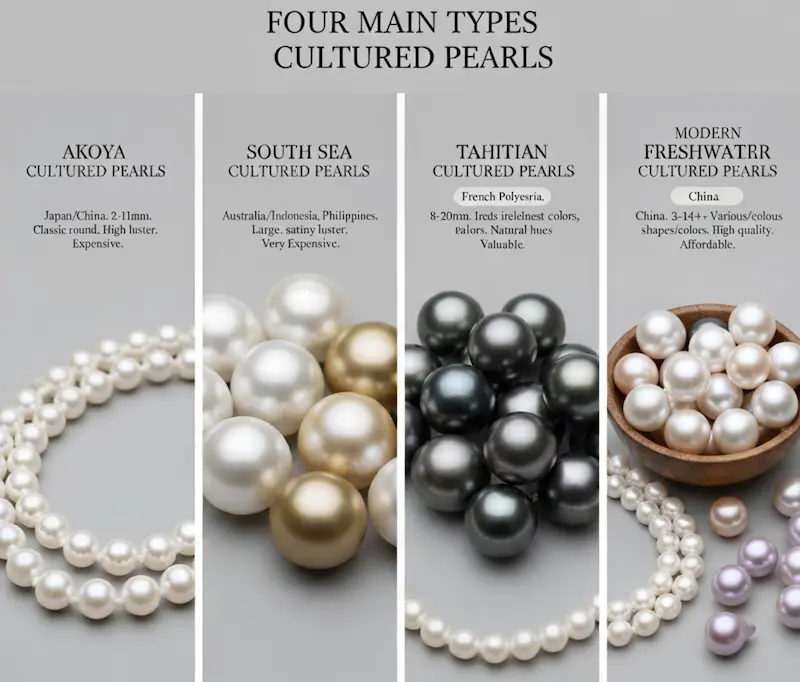
Akoya Cultured Pearls
Most people think of these when they hear the words “classic white pearl.” Akoya cultured pearls are grown mostly in saltwater in Japan and China. They are recognized for their almost flawless round shape and shine that looks like a mirror. They are usually between 2 and 11 mm wide.
People who prefer classic pearl jewelry, including beautiful strand necklaces, are usually talking about Akoyas. These pearls go through one of the most careful growing methods in the business, which is why they are among the most expensive cultured pearls.
South Sea Cultured Pearls
South Sea pearls are the queens, while Akoyas are the classics. These farmed pearls are the biggest and hardest to find on the market. They come from Australia, Indonesia, and the Philippines. They can grow to be 20mm long, which is huge compared to other types.
South Sea cultured pearls come in two main color families: white/silver or golden, depending on the species of oyster (Pinctada maxima). The cultivation period is extensive—typically 2 to 4 years—which contributes to their exceptional nacre thickness and that distinctive soft, satiny luster. A single strand can easily cost $100,000 or more.
Tahitian Cultured Pearls
Don’t be fooled by the name “black pearls.” Tahitian cultured pearls actually come in a stunning array of dark colors: silver, grey, green, blue, and purple overtones. They’re cultivated primarily in French Polynesia from the black-lipped oyster (Pinctada margaritifera).
These pearls have their own special charm. The unusual hues happen on their own, without any manipulation, which makes them very valuable. They usually grow between 8mm and 18mm and take 2 to 4 years to do so.
Freshwater Cultured Pearls
This is when things start to get really interesting from the manufacturer’s point of view. It’s amazing how much freshwater pearls have changed in the last twenty years. They used to be brushed off as cheap, crooked rice-shaped beads. Not any longer.
Modern freshwater cultivated pearls, mostly grown in China, are now as good as saltwater pearls. They come in a wide range of colors, including white, peach, lavender, pink, and more lately, some beautiful metallic colors. One freshwater mussel may create up to 25 pearls at once, which makes them easier to find and cheaper. But the quality has gone up a lot. Some freshwater cultivated pearls now come close to being perfectly round and shiny, and they can compete with Akoyas for a lot less money.
| Pearl Type | Origin | Size Range | Cultivation Time | Price Range |
|---|---|---|---|---|
| Akoya | Japan, China | 2-11mm | 10-18 months | $$ |
| South Sea | Australia, Indonesia, Philippines | 9-20mm | 2-4 years | $$$$ |
| Tahitian | French Polynesia | 8-18mm | 2-4 years | $$$ |
| Freshwater | China | 2-15mm | 1-6 years | $ |
How to Evaluate Cultured Pearl Quality
Working in this industry, I’ve learned that understanding quality factors makes all the difference. The Gemological Institute of America defines seven value factors for pearls, but let me break down what really matters when you’re buying:
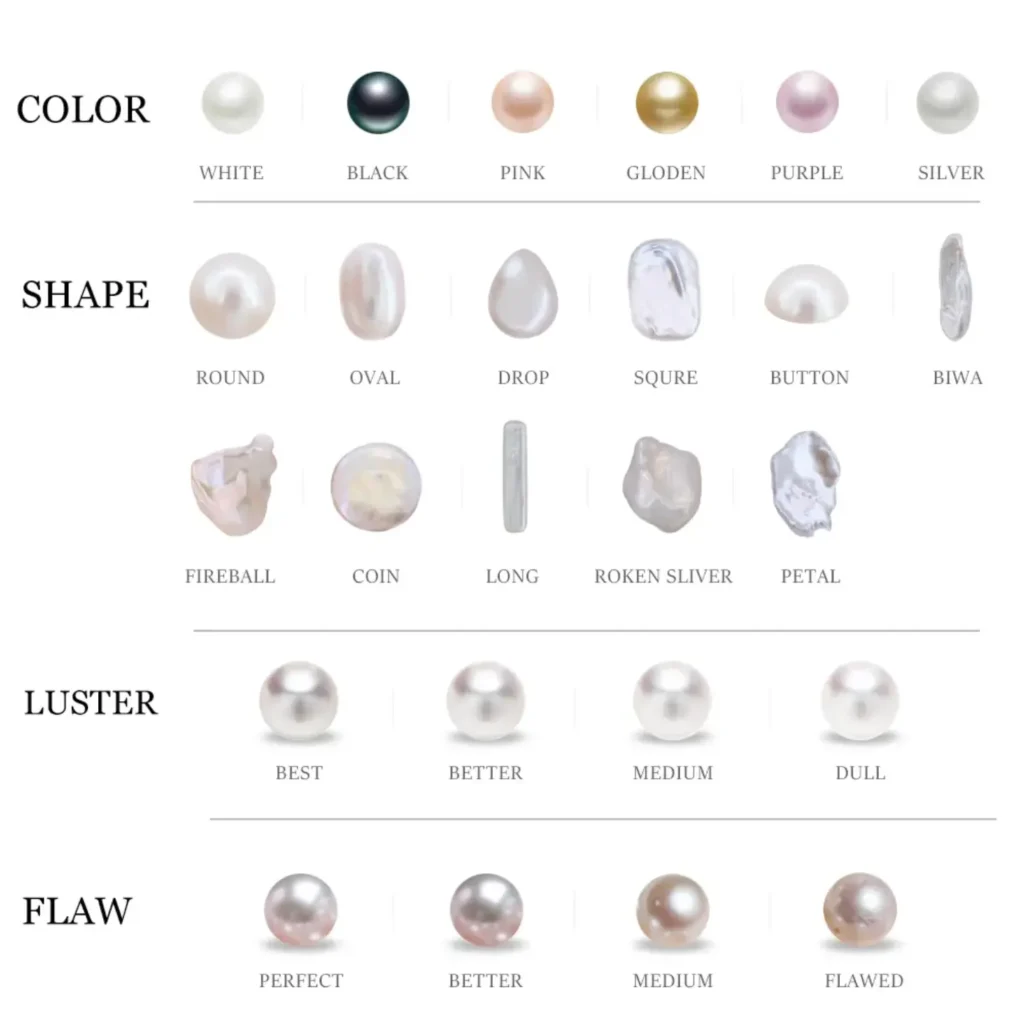
- Luster: This is the big one. Luster is the reflective quality—how sharply light reflects off the pearl’s surface. High-quality cultured pearls should have a mirror-like reflection where you can almost see your face. Dull, chalky pearls indicate thin nacre or poor quality.
- Surface Quality: Real pearls aren’t perfect. Even the finest cultured pearls might have minor surface characteristics—tiny spots, wrinkles, or irregularities. That’s actually reassuring because it proves they’re genuine. However, fewer blemishes mean higher quality.
- Shape: Round is traditionally most valuable, but don’t sleep on baroque shapes. Near-round, oval, drop, and baroque cultured pearls have become increasingly popular, especially with contemporary jewelry designers who appreciate their organic character.
- Color: This is largely personal preference, though certain colors command premiums. The color consists of the bodycolor (the dominant hue) and overtones (the subtle colors you see when light plays across the surface). Some pearls also display “orient”—that rainbow iridescence you sometimes see.
- Size: Bigger generally means more expensive, but size alone doesn’t determine value. A smaller pearl with exceptional luster will outshine a large pearl with poor surface quality any day.
Common Myths About Cultured Pearls (From Someone Who Actually Makes Them)
Myth #1: “Cultured pearls are fake.”
Wrong. We’ve covered this, but it bears repeating. Cultured pearls are genuine pearls grown inside real mollusks. They have identical chemical composition to natural pearls. The wholesale pearls industry wouldn’t exist if these weren’t real gemstones.
Myth #2: “Natural pearls are always better quality.”
That’s not true. Yes, natural pearls are harder to find. Yes, it costs more. But greater quality? Not always. A lot of natural pearls are tiny, uneven, or have thin nacre. Modern cultured pearls are developed in the best circumstances and with the help of experts. A lot of the time, the quality control is better.
Myth #3: “All cultured pearls are cheap.”
Tell that to someone who just paid $150,000 for a strand of South Sea cultured pearls. Quality cultured pearls command serious prices. The term “cultured” refers to the cultivation method, not the value.
Myth #4: “You can’t tell the difference without X-rays.”
In fact, professionals may often see changes when they use UV light or magnification. There may be a line between the nucleus and nacre layers in cultured pearls. But here’s the thing: this difference doesn’t really matter when it comes to jewelry.
The Environmental and Ethical Advantages
Here’s something that doesn’t get talked about enough: cultured pearl farming is actually good for the environment. Pearl farms require pristine water conditions to thrive. Each hectare of oyster reef filters approximately 2.7 billion liters of water annually, according to research by The Nature Conservancy.
Think about the alternative. Historical natural pearl diving was dangerous work. Divers faced drowning, shark attacks, and decompression sickness. Deaths were common. The industry decimated natural oyster populations. Cultured pearl farming changed all that. It’s safer, sustainable, and doesn’t deplete wild stocks.
Modern pearl farms are often family operations spanning generations. The farmers have every incentive to maintain water quality and treat their mollusks well. A healthy oyster produces a better pearl. It’s that simple.
How Cultured Pearls Are Actually Made: A Manufacturer’s Inside Look
I think people romanticize the process, imagining technicians in white coats hunched over microscopes. The reality is both more mundane and more fascinating.
Step 1: Preparing the Nucleus
We start with freshwater mussel shells, usually from the Mississippi River basin in the United States. These shells are cut into strips, then into cubes, then carefully ground and polished into perfect spheres. The process requires precision—these nucleus beads must be absolutely smooth and spherical.
Step 2: The Grafting Process
This requires a skilled technician with years of experience. We’re performing microsurgery on a living creature, after all. The technician makes a small incision in the oyster’s gonad (for saltwater pearls) or mantle tissue (for freshwater pearls). They insert the nucleus along with a small piece of mantle tissue from a donor oyster. This tissue is crucial—it actually grows around the nucleus and forms the pearl sac that secretes nacre.
Step 3: The Waiting Game
Now patience becomes paramount. The oysters are returned to the water, where they’re carefully monitored for months or years. Water temperature, salinity, food availability—all these factors influence the final pearl quality. Farmers must watch for disease, predators, and environmental changes. It’s farming in the truest sense.
Step 4: Harvest
When the time comes, each oyster is opened to reveal what developed inside. Not every oyster produces a gem-quality pearl. Some produce misshapen pearls. Some reject the nucleus entirely. The success rate varies, but even under ideal conditions, maybe 50-60% of cultured pearls are good enough for jewelry use.
Why the Term “Cultured” Confuses People
I think the marketing terminology deserves some blame here. When the Japanese pioneering pearl farmer Kokichi Mikimoto first brought cultured pearls to market in the early 1900s, there was fierce resistance from the natural pearl industry. They tried to ban the term “pearl” altogether for cultured varieties.
Eventually, the compromise was to use “cultured pearls” as the designation. But that word “cultured” makes it sound like something artificial—like “cultured meat” or “cultured cells” in a lab. That’s not what’s happening. These pearls grow inside living mollusks through biological processes. Nothing synthetic about it.
Some traditional jewelers further muddy the waters by referring to freshwater pearls as “cultured pearls” and Akoyas as just “pearls” or “saltwater pearls,” implying one is more “real” than the other. It’s misleading at best, predatory at worst. All commercially available pearls are cultured. Full stop.
Investment Value: Are Cultured Pearls Worth Buying?
From a pure investment standpoint, fine cultured pearls hold their value remarkably well. A strand of high-quality Akoya or South Sea cultured pearls purchased today will likely appreciate over time, especially as pearl farming faces increasing environmental challenges and costs rise.
But here’s my honest take: buy cultured pearls because you love them, not primarily as investment vehicles. Unlike diamonds, pearls are organic gems. They require care. They can be damaged by chemicals, perfumes, and even human body oils. With proper care, though, cultured pearls can last for generations.
The best investment is buying quality from reputable sources. Work with established Pearl Manufacturer suppliers who can document their pearls’ origins and quality characteristics. Understand what you’re buying. A $500 strand of high-quality cultured pearls will give you more satisfaction than a $5,000 strand of mediocre ones purchased because of fancy branding.
FAQs
Are cultured pearls real pearls?
Yes, cultured pearls are real pearls grown with human help.
Are cultured pearls worth anything?
Yes, their value ranges from modest to high depending on type, size, luster and surface.
Which is better, freshwater or cultured pearls?
“Cultured” is a method, not a type; high-grade cultured freshwater pearls can equal or surpass saltwater cultured pearls.
How can you tell if cultured pearls are fake?
Rub them gently on your teeth—real cultured pearls feel slightly gritty, while fake glass or plastic feel smooth.
The Bottom Line: Real Gems for Real People
When you buy cultured pearls—whether you’re going for classic Akoyas, exotic Tahitians, luxurious South Seas, or affordable freshwater pearls—you’re getting genuine pearls. Real gemstones. Timeless beauty that can be passed down through generations.
The cultured pearl business made it easier for everyone to get these beautiful stones. Only the rich could afford pearl jewelry a hundred years ago. Cultured pearl farming has made it possible for millions of people to enjoy the beauty and class of pearls. That’s not a deal. That’s a step forward.
When you buy cultured pearls—whether you’re going for classic Akoyas, exotic Tahitians, luxurious South Seas, or affordable freshwater pearls—you’re getting genuine pearls. Real gemstones. Timeless beauty that can be passed down through generations.
You can put the record straight the next time someone says they want “real pearls, not cultured ones.” There are true cultured pearls. They’re merely actual pearls that people and mollusks labor together to make. And there’s nothing false about it.

